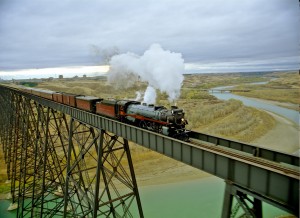
Rocky Mountain Express, created by award-winning filmmaker Stephen Low, invites its audience to experience the remarkable Rocky Mountain landscape through a historic lens.
Opening, Oct. 5, the film recounts the construction of the Canadian Pacific Railway, the nation’s first transcontinental track, completed in 1885 after years of planning and labour.
The film commemorates the many workers who met their tragic fates struggling through the problematic and, at the time, mostly uncharted mountain range, while acknowledging the incredible significance that the line’s completion had in unifying the new and developing nation of Canada. As the history unfolds, the film follows steam locomotive 2816, “The Empress,” through the winding paths of a diverse and awe-inspiring landscape.
Using 15/70 negative, the cinematography in Low’s film is impressive and extensive. Wide-angle aerial shots allow us to journey through the expansive, beautifully dangerous Rocky Mountain landscapes, while train-mounted cameras give an intimate, almost meditative, experience. Close-ups of the rhythmically jerking crankshaft and revolving wheels seem to bring them to life as the train accelerates.
While most IMAX theatres have gone digital in an effort to save costs and follow the trend, the Montreal Science Centre stays committed to its analog projectors, which actually provide its films with 25 times better quality than digital projection. Paired with Rocky Mountain’s stunning cinematography, the quality certainly shows.
While the visual detail is remarkable, the attention to sound completes the experience of the film. The rustling and trickling of the natural world is captured along with the commanding churns, bells and whistles of the 2816 locomotive. The clarity and complexity of the recording allows the audience to feel as if they are right there, hanging off the side of a steam train or walking through the Rocky mountain wilderness.
The narrative that runs through the film tells of the hardship endured by workmen who encountered near-impenetrable hard rock, crumbling mountain faces, avalanches and impossible bridge-building tasks assigned by the eccentric American surveyor Albert Bowman Rogers. Historic moments are described somewhat briefly, but in its 47-minute run time the film touches on many different elements of the CPR’s construction in an interesting and dramatic account.
The history is augmented by restored original photographs, maps of the track’s route and images of relics left by laborers; gravestones buried in vegetation along the railway, bridges abandoned for new avenues, and a makeshift hut still surviving today along a mountain-side.
The film’s focus on the struggle of the railway’s construction may in some ways reflect the film crew’s own five-year determination to fulfill their vision for Rocky Mountain Express. Low recalls that he “was deeply moved” when visiting Roger’s Pass, a landmark of the CPR and the site of a tragic avalanche in 1910. Determined to relate to his audience the experience of being in the thick of Canadian history, he declared at the press conference following the screening: “We’re going to make the film no matter what.”
If you’re interested in brushing up on your national history, experiencing the power of steam locomotives, or escaping into the Canadian wilderness for an afternoon, I recommend heading over to the Montreal Science Centre, where Rocky Mountain Express opens on Oct. 5.
For pricing and showtime information please visit montrealsciencecentre.com




